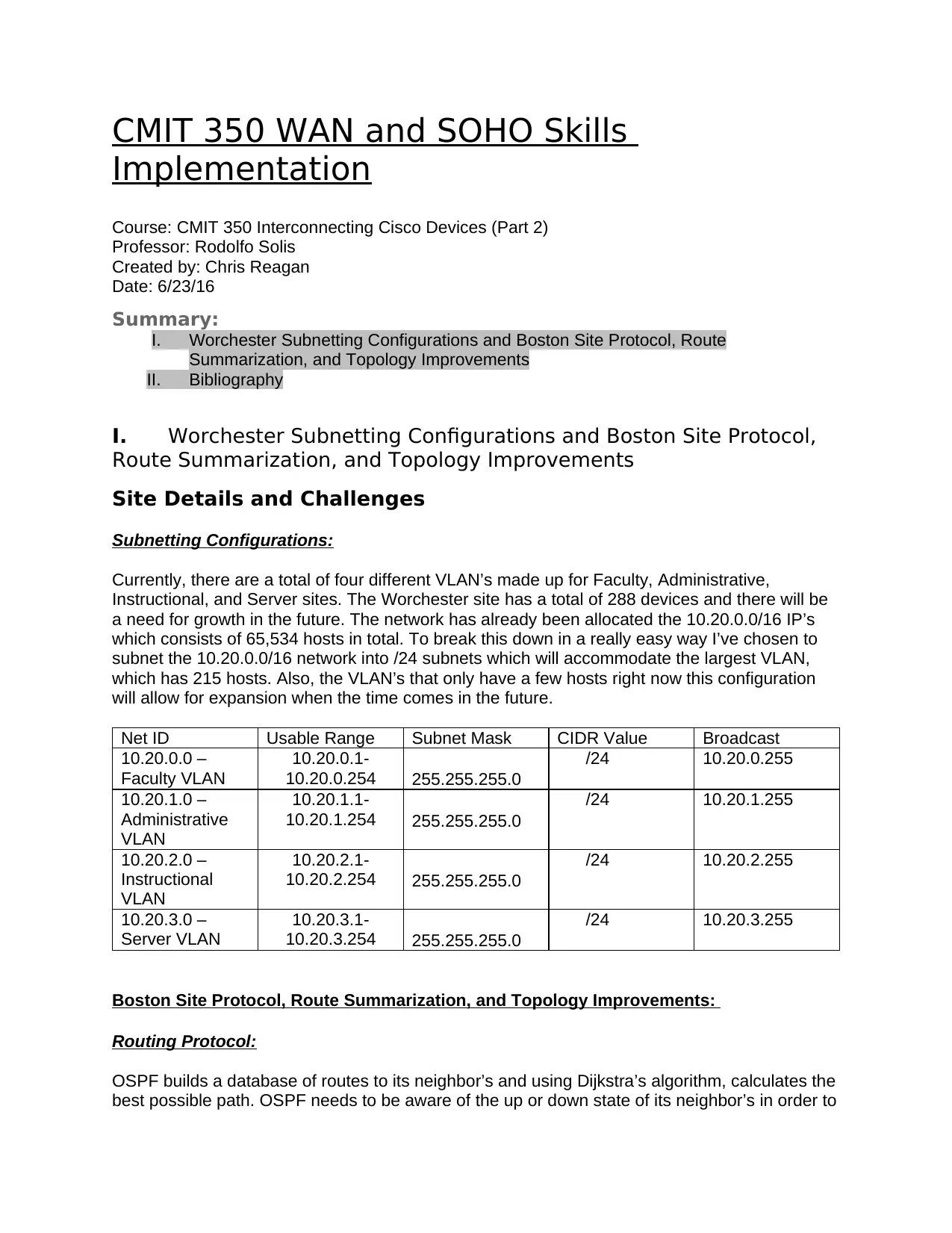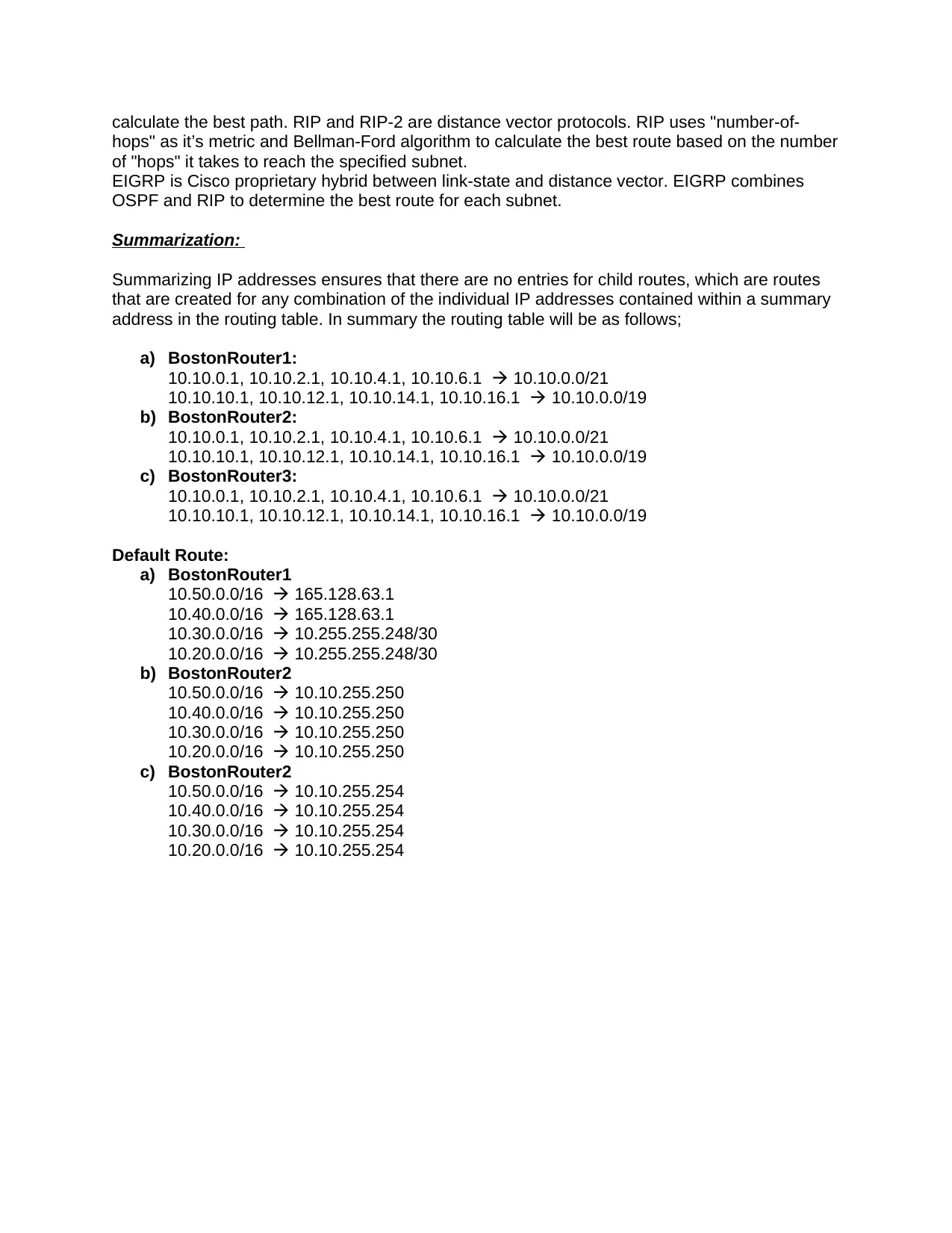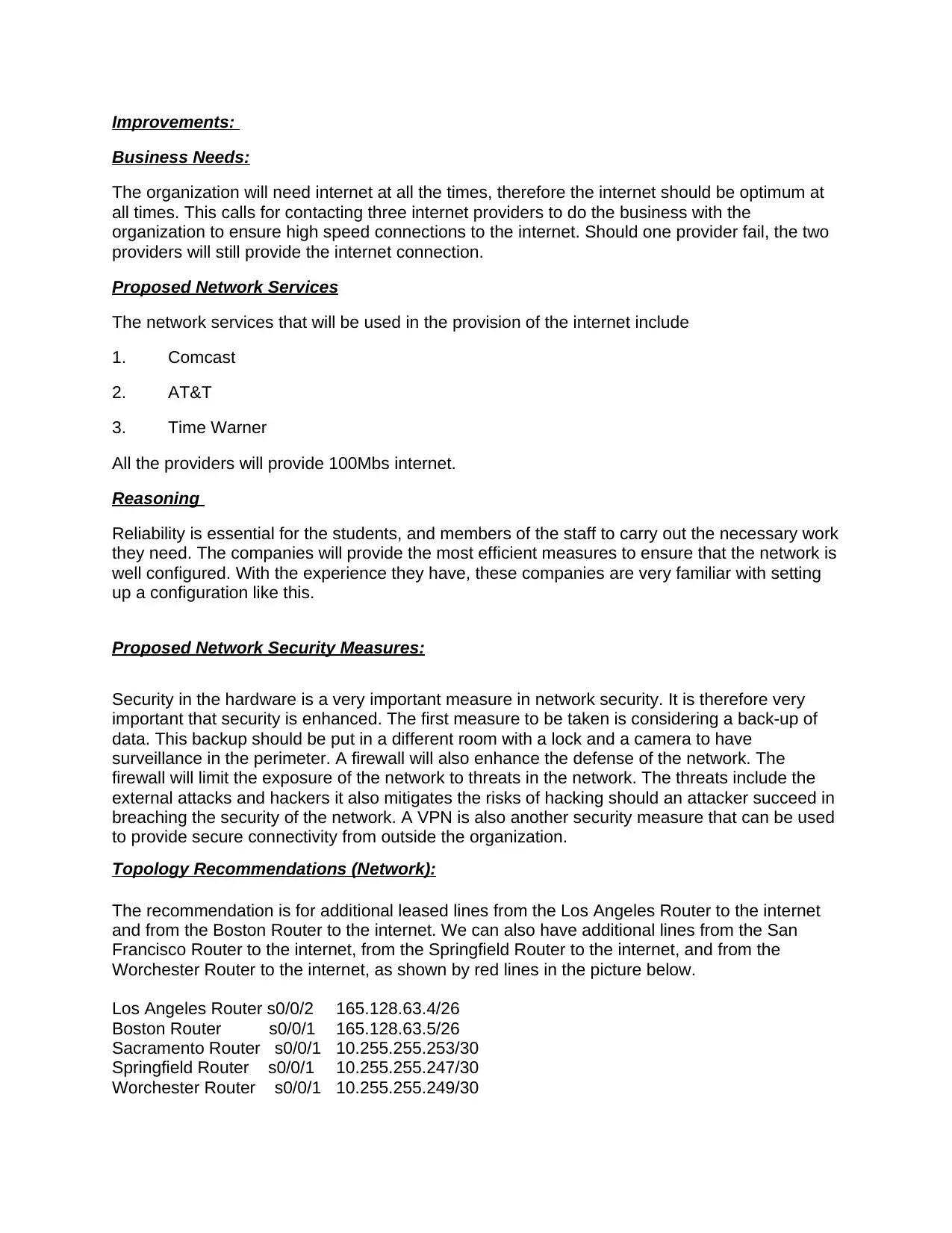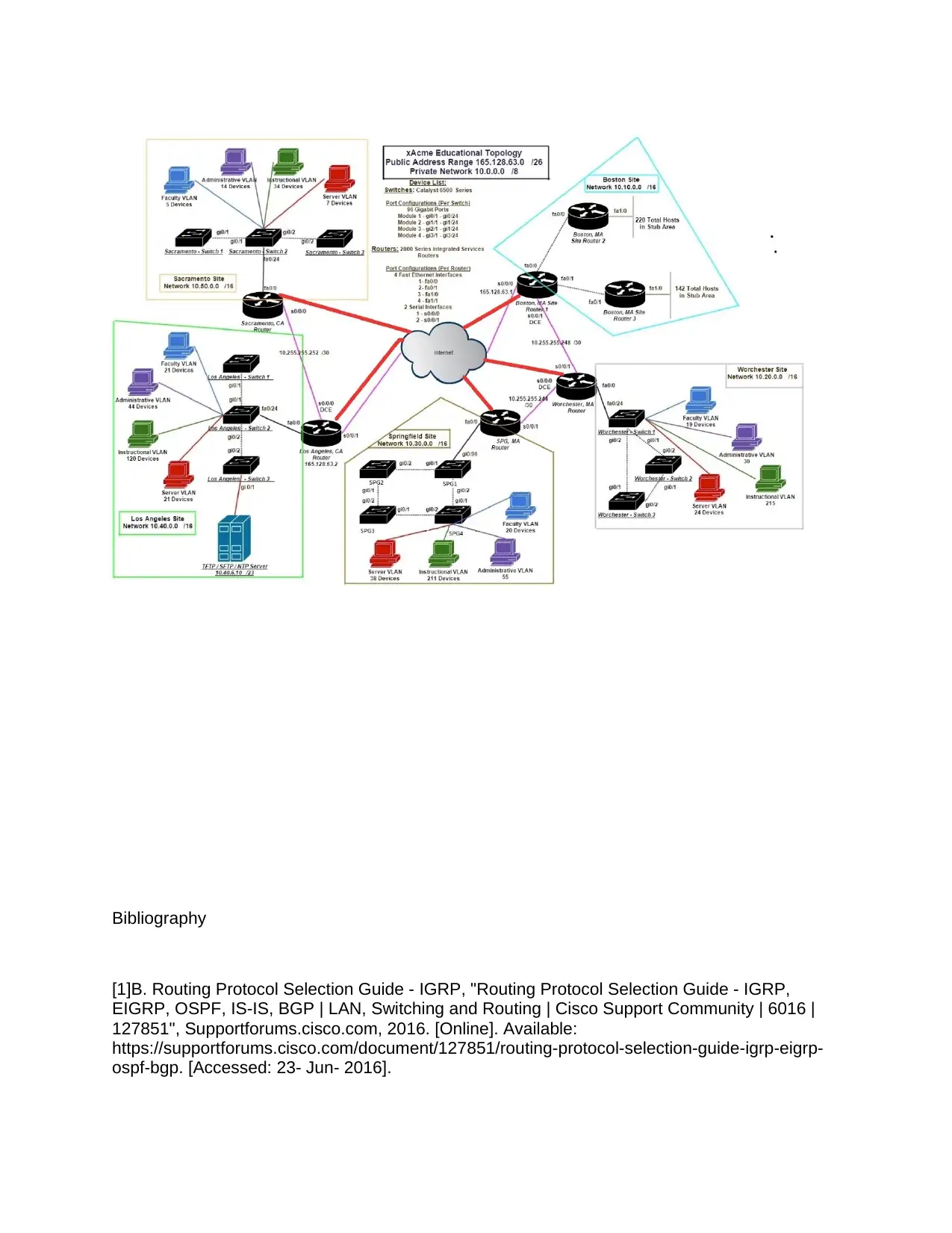CMIT 350 WAN/SOHO Skills: Subnetting, Routing, Topology Improvements
VerifiedAdded on 2019/09/21
|5
|1033
|357
Project
AI Summary
This project report, created for CMIT 350: Interconnecting Cisco Devices (Part 2), presents a comprehensive network design solution. It addresses subnetting configurations for the Worchester site, dividing the 10.20.0.0/16 network into /24 subnets to accommodate various VLANs (Faculty, Administrative, Instructional, and Server). The report details the Boston site's routing protocol selection, favoring OSPF for its efficiency, and discusses route summarization to optimize routing tables. It also proposes topology improvements, including redundant internet connections from multiple providers (Comcast, AT&T, Time Warner) to ensure network reliability and high-speed connectivity. Network security measures such as data backups, firewalls, and VPNs are recommended. The report concludes with topology recommendations for additional leased lines to enhance network performance and availability.

CMIT 350 WAN and SOHO Skills
Implementation
Course: CMIT 350 Interconnecting Cisco Devices (Part 2)
Professor: Rodolfo Solis
Created by: Chris Reagan
Date: 6/23/16
Summary:
I. Worchester Subnetting Configurations and Boston Site Protocol, Route
Summarization, and Topology Improvements
II. Bibliography
I. Worchester Subnetting Configurations and Boston Site Protocol,
Route Summarization, and Topology Improvements
Site Details and Challenges
Subnetting Configurations:
Currently, there are a total of four different VLAN’s made up for Faculty, Administrative,
Instructional, and Server sites. The Worchester site has a total of 288 devices and there will be
a need for growth in the future. The network has already been allocated the 10.20.0.0/16 IP’s
which consists of 65,534 hosts in total. To break this down in a really easy way I’ve chosen to
subnet the 10.20.0.0/16 network into /24 subnets which will accommodate the largest VLAN,
which has 215 hosts. Also, the VLAN’s that only have a few hosts right now this configuration
will allow for expansion when the time comes in the future.
Net ID Usable Range Subnet Mask CIDR Value Broadcast
10.20.0.0 –
Faculty VLAN
10.20.0.1-
10.20.0.254 255.255.255.0
/24 10.20.0.255
10.20.1.0 –
Administrative
VLAN
10.20.1.1-
10.20.1.254 255.255.255.0
/24 10.20.1.255
10.20.2.0 –
Instructional
VLAN
10.20.2.1-
10.20.2.254 255.255.255.0
/24 10.20.2.255
10.20.3.0 –
Server VLAN
10.20.3.1-
10.20.3.254 255.255.255.0
/24 10.20.3.255
Boston Site Protocol, Route Summarization, and Topology Improvements:
Routing Protocol:
OSPF builds a database of routes to its neighbor’s and using Dijkstra’s algorithm, calculates the
best possible path. OSPF needs to be aware of the up or down state of its neighbor’s in order to
Implementation
Course: CMIT 350 Interconnecting Cisco Devices (Part 2)
Professor: Rodolfo Solis
Created by: Chris Reagan
Date: 6/23/16
Summary:
I. Worchester Subnetting Configurations and Boston Site Protocol, Route
Summarization, and Topology Improvements
II. Bibliography
I. Worchester Subnetting Configurations and Boston Site Protocol,
Route Summarization, and Topology Improvements
Site Details and Challenges
Subnetting Configurations:
Currently, there are a total of four different VLAN’s made up for Faculty, Administrative,
Instructional, and Server sites. The Worchester site has a total of 288 devices and there will be
a need for growth in the future. The network has already been allocated the 10.20.0.0/16 IP’s
which consists of 65,534 hosts in total. To break this down in a really easy way I’ve chosen to
subnet the 10.20.0.0/16 network into /24 subnets which will accommodate the largest VLAN,
which has 215 hosts. Also, the VLAN’s that only have a few hosts right now this configuration
will allow for expansion when the time comes in the future.
Net ID Usable Range Subnet Mask CIDR Value Broadcast
10.20.0.0 –
Faculty VLAN
10.20.0.1-
10.20.0.254 255.255.255.0
/24 10.20.0.255
10.20.1.0 –
Administrative
VLAN
10.20.1.1-
10.20.1.254 255.255.255.0
/24 10.20.1.255
10.20.2.0 –
Instructional
VLAN
10.20.2.1-
10.20.2.254 255.255.255.0
/24 10.20.2.255
10.20.3.0 –
Server VLAN
10.20.3.1-
10.20.3.254 255.255.255.0
/24 10.20.3.255
Boston Site Protocol, Route Summarization, and Topology Improvements:
Routing Protocol:
OSPF builds a database of routes to its neighbor’s and using Dijkstra’s algorithm, calculates the
best possible path. OSPF needs to be aware of the up or down state of its neighbor’s in order to
Paraphrase This Document
Need a fresh take? Get an instant paraphrase of this document with our AI Paraphraser

calculate the best path. RIP and RIP-2 are distance vector protocols. RIP uses "number-of-
hops" as it’s metric and Bellman-Ford algorithm to calculate the best route based on the number
of "hops" it takes to reach the specified subnet.
EIGRP is Cisco proprietary hybrid between link-state and distance vector. EIGRP combines
OSPF and RIP to determine the best route for each subnet.
Summarization:
Summarizing IP addresses ensures that there are no entries for child routes, which are routes
that are created for any combination of the individual IP addresses contained within a summary
address in the routing table. In summary the routing table will be as follows;
a) BostonRouter1:
10.10.0.1, 10.10.2.1, 10.10.4.1, 10.10.6.1 10.10.0.0/21
10.10.10.1, 10.10.12.1, 10.10.14.1, 10.10.16.1 10.10.0.0/19
b) BostonRouter2:
10.10.0.1, 10.10.2.1, 10.10.4.1, 10.10.6.1 10.10.0.0/21
10.10.10.1, 10.10.12.1, 10.10.14.1, 10.10.16.1 10.10.0.0/19
c) BostonRouter3:
10.10.0.1, 10.10.2.1, 10.10.4.1, 10.10.6.1 10.10.0.0/21
10.10.10.1, 10.10.12.1, 10.10.14.1, 10.10.16.1 10.10.0.0/19
Default Route:
a) BostonRouter1
10.50.0.0/16 165.128.63.1
10.40.0.0/16 165.128.63.1
10.30.0.0/16 10.255.255.248/30
10.20.0.0/16 10.255.255.248/30
b) BostonRouter2
10.50.0.0/16 10.10.255.250
10.40.0.0/16 10.10.255.250
10.30.0.0/16 10.10.255.250
10.20.0.0/16 10.10.255.250
c) BostonRouter2
10.50.0.0/16 10.10.255.254
10.40.0.0/16 10.10.255.254
10.30.0.0/16 10.10.255.254
10.20.0.0/16 10.10.255.254
hops" as it’s metric and Bellman-Ford algorithm to calculate the best route based on the number
of "hops" it takes to reach the specified subnet.
EIGRP is Cisco proprietary hybrid between link-state and distance vector. EIGRP combines
OSPF and RIP to determine the best route for each subnet.
Summarization:
Summarizing IP addresses ensures that there are no entries for child routes, which are routes
that are created for any combination of the individual IP addresses contained within a summary
address in the routing table. In summary the routing table will be as follows;
a) BostonRouter1:
10.10.0.1, 10.10.2.1, 10.10.4.1, 10.10.6.1 10.10.0.0/21
10.10.10.1, 10.10.12.1, 10.10.14.1, 10.10.16.1 10.10.0.0/19
b) BostonRouter2:
10.10.0.1, 10.10.2.1, 10.10.4.1, 10.10.6.1 10.10.0.0/21
10.10.10.1, 10.10.12.1, 10.10.14.1, 10.10.16.1 10.10.0.0/19
c) BostonRouter3:
10.10.0.1, 10.10.2.1, 10.10.4.1, 10.10.6.1 10.10.0.0/21
10.10.10.1, 10.10.12.1, 10.10.14.1, 10.10.16.1 10.10.0.0/19
Default Route:
a) BostonRouter1
10.50.0.0/16 165.128.63.1
10.40.0.0/16 165.128.63.1
10.30.0.0/16 10.255.255.248/30
10.20.0.0/16 10.255.255.248/30
b) BostonRouter2
10.50.0.0/16 10.10.255.250
10.40.0.0/16 10.10.255.250
10.30.0.0/16 10.10.255.250
10.20.0.0/16 10.10.255.250
c) BostonRouter2
10.50.0.0/16 10.10.255.254
10.40.0.0/16 10.10.255.254
10.30.0.0/16 10.10.255.254
10.20.0.0/16 10.10.255.254

Improvements:
Business Needs:
The organization will need internet at all the times, therefore the internet should be optimum at
all times. This calls for contacting three internet providers to do the business with the
organization to ensure high speed connections to the internet. Should one provider fail, the two
providers will still provide the internet connection.
Proposed Network Services
The network services that will be used in the provision of the internet include
1. Comcast
2. AT&T
3. Time Warner
All the providers will provide 100Mbs internet.
Reasoning
Reliability is essential for the students, and members of the staff to carry out the necessary work
they need. The companies will provide the most efficient measures to ensure that the network is
well configured. With the experience they have, these companies are very familiar with setting
up a configuration like this.
Proposed Network Security Measures:
Security in the hardware is a very important measure in network security. It is therefore very
important that security is enhanced. The first measure to be taken is considering a back-up of
data. This backup should be put in a different room with a lock and a camera to have
surveillance in the perimeter. A firewall will also enhance the defense of the network. The
firewall will limit the exposure of the network to threats in the network. The threats include the
external attacks and hackers it also mitigates the risks of hacking should an attacker succeed in
breaching the security of the network. A VPN is also another security measure that can be used
to provide secure connectivity from outside the organization.
Topology Recommendations (Network):
The recommendation is for additional leased lines from the Los Angeles Router to the internet
and from the Boston Router to the internet. We can also have additional lines from the San
Francisco Router to the internet, from the Springfield Router to the internet, and from the
Worchester Router to the internet, as shown by red lines in the picture below.
Los Angeles Router s0/0/2 165.128.63.4/26
Boston Router s0/0/1 165.128.63.5/26
Sacramento Router s0/0/1 10.255.255.253/30
Springfield Router s0/0/1 10.255.255.247/30
Worchester Router s0/0/1 10.255.255.249/30
Business Needs:
The organization will need internet at all the times, therefore the internet should be optimum at
all times. This calls for contacting three internet providers to do the business with the
organization to ensure high speed connections to the internet. Should one provider fail, the two
providers will still provide the internet connection.
Proposed Network Services
The network services that will be used in the provision of the internet include
1. Comcast
2. AT&T
3. Time Warner
All the providers will provide 100Mbs internet.
Reasoning
Reliability is essential for the students, and members of the staff to carry out the necessary work
they need. The companies will provide the most efficient measures to ensure that the network is
well configured. With the experience they have, these companies are very familiar with setting
up a configuration like this.
Proposed Network Security Measures:
Security in the hardware is a very important measure in network security. It is therefore very
important that security is enhanced. The first measure to be taken is considering a back-up of
data. This backup should be put in a different room with a lock and a camera to have
surveillance in the perimeter. A firewall will also enhance the defense of the network. The
firewall will limit the exposure of the network to threats in the network. The threats include the
external attacks and hackers it also mitigates the risks of hacking should an attacker succeed in
breaching the security of the network. A VPN is also another security measure that can be used
to provide secure connectivity from outside the organization.
Topology Recommendations (Network):
The recommendation is for additional leased lines from the Los Angeles Router to the internet
and from the Boston Router to the internet. We can also have additional lines from the San
Francisco Router to the internet, from the Springfield Router to the internet, and from the
Worchester Router to the internet, as shown by red lines in the picture below.
Los Angeles Router s0/0/2 165.128.63.4/26
Boston Router s0/0/1 165.128.63.5/26
Sacramento Router s0/0/1 10.255.255.253/30
Springfield Router s0/0/1 10.255.255.247/30
Worchester Router s0/0/1 10.255.255.249/30
⊘ This is a preview!⊘
Do you want full access?
Subscribe today to unlock all pages.

Trusted by 1+ million students worldwide

Bibliography
[1]B. Routing Protocol Selection Guide - IGRP, "Routing Protocol Selection Guide - IGRP,
EIGRP, OSPF, IS-IS, BGP | LAN, Switching and Routing | Cisco Support Community | 6016 |
127851", Supportforums.cisco.com, 2016. [Online]. Available:
https://supportforums.cisco.com/document/127851/routing-protocol-selection-guide-igrp-eigrp-
ospf-bgp. [Accessed: 23- Jun- 2016].
[1]B. Routing Protocol Selection Guide - IGRP, "Routing Protocol Selection Guide - IGRP,
EIGRP, OSPF, IS-IS, BGP | LAN, Switching and Routing | Cisco Support Community | 6016 |
127851", Supportforums.cisco.com, 2016. [Online]. Available:
https://supportforums.cisco.com/document/127851/routing-protocol-selection-guide-igrp-eigrp-
ospf-bgp. [Accessed: 23- Jun- 2016].
Paraphrase This Document
Need a fresh take? Get an instant paraphrase of this document with our AI Paraphraser

[2]D. Teare and C. Paquet, "Route Summarization > CCNP Self-Study: Advanced IP
Addressing", Ciscopress.com, 2016. [Online]. Available:
http://www.ciscopress.com/articles/article.asp?p=174107&seqNum=3. [Accessed: 23- Jun-
2016].
[3]"Networking 101: Understanding OSPF Routing", Enterprisenetworkingplanet.com, 2016.
[Online]. Available: http://www.enterprisenetworkingplanet.com/netsp/article.php/3610496/
Networking-101-Understanding-OSPF-Routing.htm. [Accessed: 23- Jun- 2016].
Addressing", Ciscopress.com, 2016. [Online]. Available:
http://www.ciscopress.com/articles/article.asp?p=174107&seqNum=3. [Accessed: 23- Jun-
2016].
[3]"Networking 101: Understanding OSPF Routing", Enterprisenetworkingplanet.com, 2016.
[Online]. Available: http://www.enterprisenetworkingplanet.com/netsp/article.php/3610496/
Networking-101-Understanding-OSPF-Routing.htm. [Accessed: 23- Jun- 2016].
1 out of 5
Your All-in-One AI-Powered Toolkit for Academic Success.
+13062052269
info@desklib.com
Available 24*7 on WhatsApp / Email
![[object Object]](/_next/static/media/star-bottom.7253800d.svg)
Unlock your academic potential
Copyright © 2020–2025 A2Z Services. All Rights Reserved. Developed and managed by ZUCOL.
